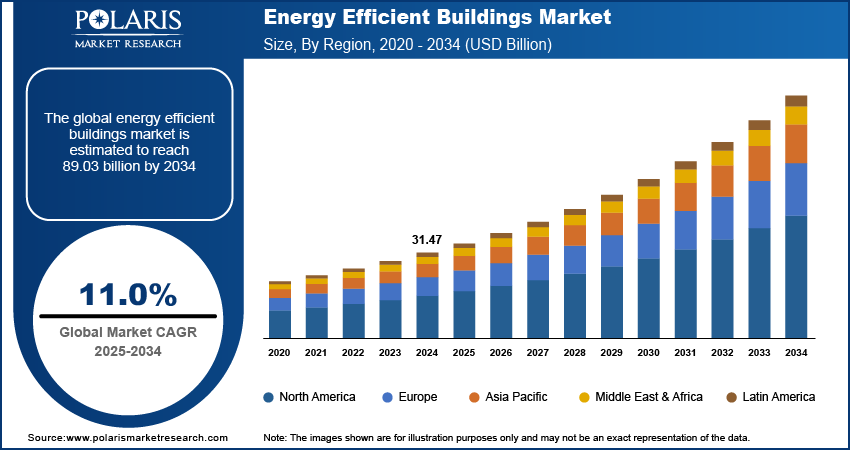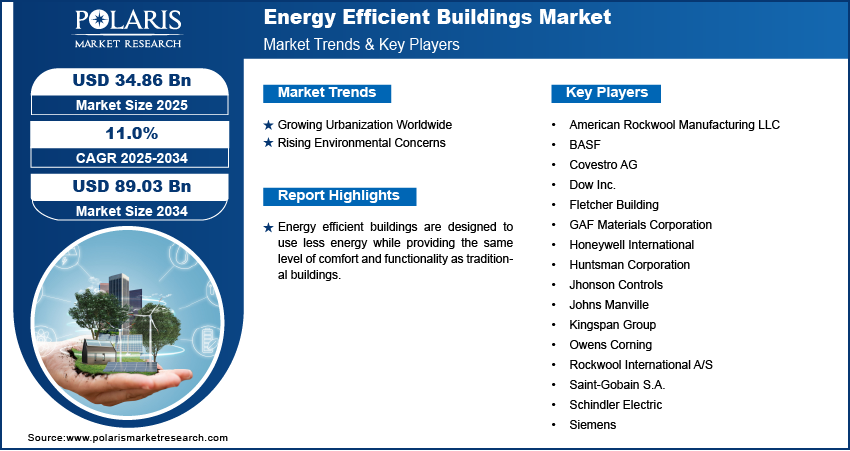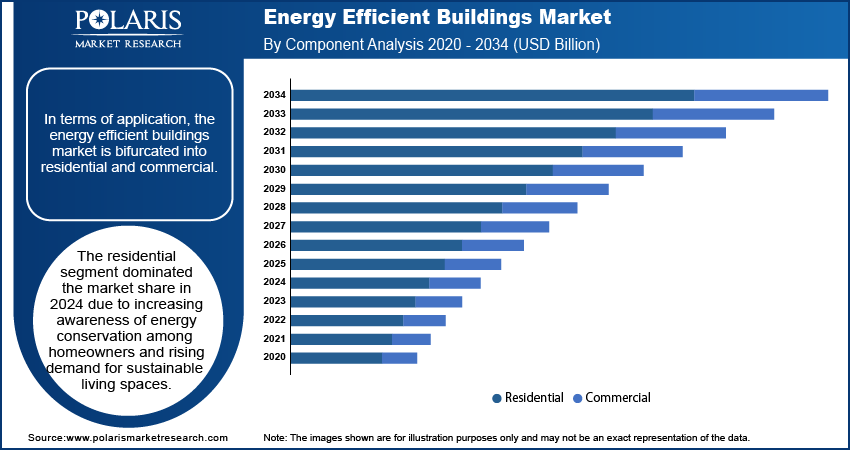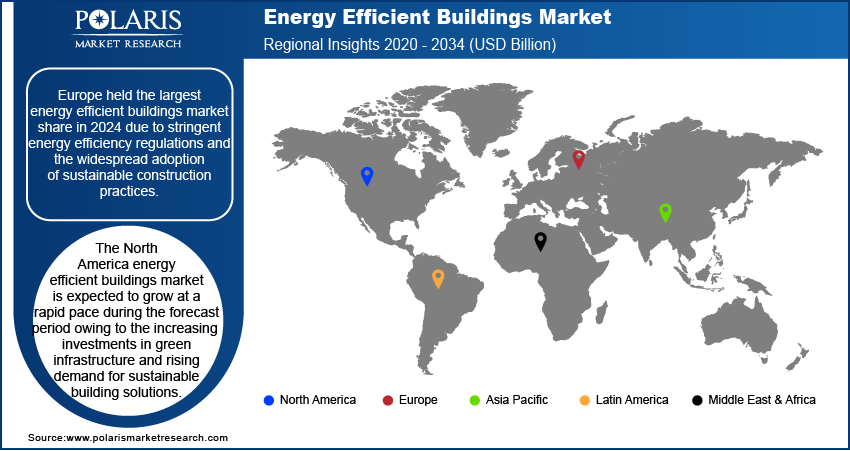
Energy Efficient Buildings Market Size, Share, Trends, Industry Analysis Report: By Material [Glass Wool, Mineral Wool, Expanded Polystyrene (EPS), and Extruded Polystyrene (XPS)], Component Type, Application, and Region (North America, Europe, Asia Pacific, Latin America, and Middle East & Africa) – Market Forecast, 2025–2034
- Published Date:Feb-2025
- Pages: 129
- Format: PDF
- Report ID: PM5386
- Base Year: 2024
- Historical Data: 2020-2023
Energy Efficient Buildings Market Overview
The global energy efficient buildings market size was valued at USD 31.47 billion in 2024. The market is projected to grow from USD 34.86 billion in 2025 to USD 89.03 billion by 2034, exhibiting a CAGR of 11.0% during 2025–2034.
Energy efficient buildings are designed to use less energy while providing the same level of comfort and functionality as traditional buildings. This is achieved through various strategies that minimize energy waste, such as improving insulation, using high-quality windows, and incorporating renewable energy sources, including solar panels. These buildings usually feature designs that maximize natural light and ventilation, reducing the need for artificial heating and cooling.
The increasing energy prices worldwide are propelling the global energy efficient buildings market growth. World Economic Forum states that energy prices have surged since the Russia-Ukraine war, leading to an increase in household energy costs. High energy costs significantly impact utility bills, prompting property owners and developers to prioritize solutions that minimize energy consumption. Energy-efficient buildings, which incorporate advanced insulation, efficient HVAC systems, renewable energy sources, and smart energy management technologies, offer a solution to reduce rising energy costs by minimizing energy consumption.

To Understand More About this Research: Request a Free Sample Report
The energy efficient buildings market demand is driven by growing investments in smart city projects. Smart cities are designed to integrate advanced technologies and infrastructure to improve energy efficiency, reduce environmental impact, and enhance the quality of life for residents. Energy-efficient buildings are a core component of smart city projects, as they reduce energy consumption and greenhouse gas emissions, aligning with the goals of smart cities. Therefore, as governments and private entities fund smart city projects, they increasingly mandate energy-efficient designs for new constructions, driving demand for energy-efficient building technologies. For instance, the Government of India released ₹46,787 crore (USD 5,487.08 million) to develop 100 Smart Cities under the smart city mission as of September 2024.
Energy Efficient Buildings Market Dynamics
Growing Urbanization Worldwide
The growing urbanization worldwide is projected to propel the global energy efficient buildings market expansion. According to the United Nations, more than half of the global population lives in urban areas, up from around one-third in 1950 and projected to increase to around two-thirds in 2050. Urbanization leads to a rise in the demand for housing, commercial spaces, and public facilities, putting pressure on energy resources and contributing to higher carbon emissions. Energy-efficient buildings address these challenges by minimizing energy consumption through advanced technologies such as insulation, efficient lighting, renewable energy systems, and smart energy management solutions. Urbanization also drives stricter building regulations and sustainability standards to mitigate environmental impacts, further incentivizing energy-efficient construction, thereby boosting the energy efficient buildings market demand.
Rising Environmental Concerns
Awareness of climate change, resource depletion, and rising greenhouse gas emissions among governments globally has created the need for sustainable solutions in the residential environment, which is a major contributor to global energy consumption and carbon emissions. Energy-efficient buildings designed to minimize energy use through innovations such as improved insulation, high-efficiency HVAC systems, and renewable energy integration address these concerns. Additionally, eco-conscious consumers and investors increasingly favor environmentally responsible properties, while governments implement stricter regulations and incentives to promote sustainable construction. This combination of awareness and policy propels the adoption of energy-efficient buildings as a critical element in addressing environmental challenges. Hence, the rising environmental concerns are estimated to fuel the global energy efficient buildings market growth during the forecast period.

Energy Efficient Buildings Market Segment Analysis
Energy Efficient Buildings Market Assessment by Material
Based on material, the energy efficient buildings market is categorized into glass wool, mineral wool, expanded polystyrene (EPS), and extruded polystyrene (XPS). The glass wool segment held the largest energy efficient buildings market share in 2024 due to its exceptional thermal insulation properties, cost-effectiveness, and widespread availability. Glass wool is extensively used in both residential and commercial construction due to its ability to reduce heat transfer and enhance energy efficiency. The material is lightweight, easy to install, and versatile, making it suitable for applications ranging from walls to ceilings and HVAC systems. Stringent building codes and sustainability standards aimed at reducing energy consumption and greenhouse gas emissions further drive the adoption of glass wool.
The expanded polystyrene (EPS) segment is estimated to grow at a robust pace in the coming years, owing to its excellent insulation performance, durability, and adaptability to various applications. Its closed-cell structure provides superior resistance to moisture and thermal conductivity, making it ideal for insulating building envelopes and foundations. Growing urbanization and the rising popularity of green building certifications have driven demand for materials such as EPS that enhance energy performance. Additionally, innovations in manufacturing processes and increased use of EPS in modular and prefabricated construction further contribute to its rapid growth.
Energy Efficient Buildings Market Evaluation by Application
In terms of application, the energy efficient buildings market is bifurcated into residential and commercial. The residential segment dominated the energy efficient buildings market share in 2024 due to increasing awareness of energy conservation among homeowners and rising demand for sustainable living spaces. Governments worldwide have implemented strict building codes and offered incentives, such as tax rebates and subsidies, to encourage energy-efficient upgrades in residential properties. The growing popularity of smart home technologies has further fueled the segment as homeowners increasingly adopt energy-efficient appliances, lighting systems, and insulation materials to reduce energy costs.

Energy Efficient Buildings Market Regional Insights
By region, the study provides the energy efficient buildings market insights into North America, Europe, Asia Pacific, Latin America, and the Middle East & Africa. Europe held the largest share of the global energy efficient buildings market revenue in 2024 due to stringent energy efficiency regulations and the widespread adoption of sustainable construction practices. The European Union’s commitment to achieving carbon neutrality by 2050 has propelled the implementation of policies such as the Energy Performance of Buildings Directive (EPBD), which mandates higher energy performance standards for new and existing structures. Germany, with its progressive energy policies and substantial investments in green building initiatives, has played a major role in the region's dominance. Strong public awareness of climate change, coupled with government incentives and subsidies for energy-efficient buildings, has further accelerated the adoption of advanced technologies and materials across Europe.
The North America energy efficient buildings market is expected to grow at a rapid pace during the forecast period owing to the increasing investments in green infrastructure and rising demand for sustainable building solutions. The US, as the leading country in the region, has witnessed rapid advancements in energy-efficient buildings, driven by federal initiatives such as the Inflation Reduction Act and state-level policies promoting renewable energy integration and energy conservation. Additionally, a focus on reducing energy dependency has encouraged residential and commercial developers to prioritize energy-efficient technologies, positioning North America as a key region in the global market.

Energy Efficient Buildings Market – Key Players and Competitive Analysis Report
Major market players are investing heavily in research and development to expand their offerings, which will help the energy efficient buildings market grow even more. Market participants are also undertaking a variety of strategic activities to expand their global footprint, with important market developments such as innovative launches, international collaborations, higher investments, and mergers and acquisitions between organizations.
The energy efficient buildings market is fragmented, with the presence of numerous global and regional market players. A few major players in the energy efficient buildings market are Kingspan Group, Covestro AG, Dow Inc., Huntsman Corporation, Rockwool International A/S, Fletcher Building, American Rockwool Manufacturing LLC, Saint-Gobain S.A., Owens Corning, Johns Manville, GAF Materials Corporation, BASF, Jhonson Controls, Siemens, Honeywell International, and Schindler Electric.
Saint-Gobain S.A., founded in 1665, is a prominent multinational corporation headquartered in Courbevoie, France. The company is a global player in the construction materials industry, particularly recognized for its commitment to energy-efficient buildings. The company offers a wide range of innovative products and solutions designed to improve the energy performance of buildings. For instance, their magnetron-coated glass products enhance insulation and solar protection, helping to maintain comfortable indoor climates regardless of external weather conditions.
Dow Inc. is a global materials science company headquartered in Midland, Michigan, with a rich history that dates back to its founding in 1897 by chemist Herbert Henry Dow. The company plays a significant role in promoting energy-efficient buildings through innovative solutions and sustainable practices. Dow focuses on developing high-performance building materials that enhance energy efficiency and contribute to reducing greenhouse gas emissions. The company operates across around 160 countries. This extensive reach allows Dow to serve diverse markets, including packaging, infrastructure, mobility, and consumer care.
List of Key Companies in Energy Efficient Buildings Market
- American Rockwool Manufacturing LLC
- BASF
- Covestro AG
- Dow Inc.
- Fletcher Building
- GAF Materials Corporation
- Honeywell International
- Huntsman Corporation
- Jhonson Controls
- Johns Manville
- Kingspan Group
- Owens Corning
- Rockwool International A/S
- Saint-Gobain S.A.
- Schindler Electric
- Siemens
Energy Efficient Buildings Industry Developments
June 2024: Honeywell, a company that manufactures and invents technologies for a variety of industries, including aerospace, building automation, and safety and productivity solutions, introduced Connected Power, a groundbreaking solution that helps monitor, manage, and automate buildings' power usage at the plug level.
June 2023: Saint-Gobain, a company that designs, manufactures, and distributes materials and services for construction and industrial applications, launched the production of India's first low-carbon glass that can reduce approximately 40% carbon footprint compared to the existing Saint-Gobain Glass products.
May 2023: Honeywell launched Honeywell Forge for buildings that features software, hardware, and services to deliver key outcomes to help building owners and operators achieve sustainability, operational efficiency, occupant experience, compliance, safety and security, and resilience goals.
Energy Efficient Buildings Market Segmentation
By Material Outlook (Revenue, USD Billion, 2020–2034)
- Glass Wool
- Mineral Wool
- Expanded Polystyrene (EPS)
- Extruded Polystyrene (XPS)
By Component Type Outlook (Revenue, USD Billion, 2020–2034)
- Ventilation Systems
- Lighting Technologies
- Energy Management Systems
- Controls
By Application Outlook (Revenue, USD Billion, 2020–2034)
- Residential
- Commercial
By Regional Outlook (Revenue, USD Billion, 2020–2034)
- North America
- US
- Canada
- Europe
- Germany
- France
- UK
- Italy
- Spain
- Netherlands
- Russia
- Rest of Europe
- Asia Pacific
- China
- Japan
- India
- Malaysia
- South Korea
- Indonesia
- Australia
- Vietnam
- Rest of Asia Pacific
- Middle East & Africa
- Saudi Arabia
- UAE
- Israel
- South Africa
- Rest of Middle East & Africa
- Latin America
- Mexico
- Brazil
- Argentina
- Rest of Latin America
Energy Efficient Buildings Market Report Scope
|
Report Attributes |
Details |
|
Market Size Value in 2024 |
USD 31.47 billion |
|
Market Size Value in 2025 |
USD 34.86 billion |
|
Revenue Forecast by 2034 |
USD 89.03 billion |
|
CAGR |
11.0% from 2025 to 2034 |
|
Base Year |
2024 |
|
Historical Data |
2020–2023 |
|
Forecast Period |
2025–2034 |
|
Quantitative Units |
Revenue in USD Billion and CAGR from 2025 to 2034 |
|
Report Coverage |
Revenue Forecast, Market Competitive Landscape, Growth Factors, and Trends |
|
Segments Covered |
|
|
Regional Scope |
|
|
Competitive Landscape |
|
|
Report Format |
|
|
Customization |
Report customization as per your requirements with respect to countries, regions, and segmentation. |
FAQ's
• The global energy efficient buildings market size was valued at USD 31.47 billion in 2024 and is projected to grow to USD 89.03 billion by 2034
• The global market is projected to register a CAGR of 11.0% during the forecast period.
• Europe held the largest share of the global market in 2024.
• A few of the key players in the market are Kingspan Group, Covestro AG, Dow Inc., Huntsman Corporation, Rockwool International A/S, Fletcher Building, American Rockwool Manufacturing LLC, Saint-Gobain S.A., Owens Corning, Johns Manville, GAF Materials Corporation, BASF, Jhonson Controls, Siemens, Honeywell International, and Schindler Electric.
• The expanded polystyrene (EPS) segment is projected for significant growth in the global market during the forecast period.
• The residential segment dominated the energy efficient buildings market share in 2024.
